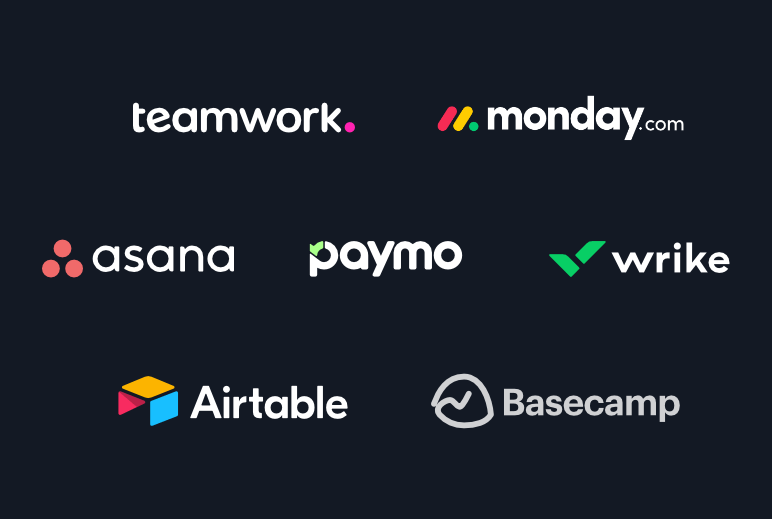You walk into the office on a Monday morning dreading the day ahead.
You have no idea how things started spiraling out of control. The team is expanding, task allocation and tracking progress is becoming nearly impossible, and new projects keep coming in.
How you wish you could do something.
Some good news?
You still can – with project management software (read this article first to see how pm tools work).
After a point of time, streamlining the workflows under a single platform and keeping team members in the loop becomes inevitable. You need an antidote to the chaos that ensues from complex work structures and large teams.
That’s where project management software comes in. It is a tool that a wide range of industries use for project planning, scheduling, resource allocation, and change management.
Project management software helps you fill in the gaps caused by task allocation and management. They’re truly a blessing for project managers looking for clarity about what needs to be done, who needs to do it, and when and how it will be completed.
This article lists some of the top ways a project management software can help you improve workflows, boost productivity, and ensure successful project completion.
Let’s check them out.
1. Conceptualization
A lot of planning relies on guesswork – doubts about the project deadline, the person responsible for completing the same, and the inevitable hindrances that continuously loom over the planning process. The end plan eventually becomes an imaginative representation of what the project should look like.
But with project management software, things look different. You’re not making decisions based simply on trust and hope. It gathers information from past projects, provides the required data and figures to ultimately remove the guesswork in project execution, and bases the project planning on concrete facts.
Before conceptualizing the project, managers can use the tools to check for resource availability, costs, and historical information. It ultimately helps with resource allocation and checks for adjustments needed in the current project to ensure its success.
2. Resource Allocation
Resource allocation is one of the primary tasks in project management. But it is also where things can get tricky. Especially when you’re dealing with multiple skill sets and large teams. Research says 11.4% of resources are wasted due to poor task management.
Your end goal is obviously to ensure the successful completion of the project. But before you know it, the project becomes about who’s doing what and a game of blame.
Besides, market dynamics and priorities can also impact teams to change their timelines. As a result, you cannot always expect that your plan for resource allocation will be followed diligently.
For example, for eCommerce suppliers, the demand for a particular product drives the market. Even if you decide to keep specific stock units at an eCommerce fulfillment center, you can expect shortages due to fluctuating demand. And let’s face it, keeping up with today’s pace of change and making end-to-end adjustments manually is painstaking.
But project management software gives you real-time data helping you figure out the plan and prioritize based on data updated in real-time. The demand planning reconciles the volume of work that needs to be done with the resources available. You can also run alternative scenarios by plugging in variables and allowing the system to predict the impact, such as raw material shortage.
3. Delegating Tasks
All project management workflow requires assigning tasks and activities to individuals or even departments. A lot of times workflows are repetitive, yet managers find it difficult to delegate tasks effectively and fairly to members. It eventually impacts the efficiency and dynamic of the whole team.
Project management software allows centralized communication between teams and managers, making it easier for leaders to delegate tasks, set deadlines, and update any changes in the task or deadline.
You can also use pre-made project management templates to save you and your team manual work in the long run. It will automate the delegation of routine tasks and even customize the template if need be.
It also makes it easier for your team members. Instead of asking managers about their daily tasks, they simply have to check the project management tool to understand the agenda of the day. Most software also comes with automatic reminders before the deadlines to ensure that the deliveries are on-time and efficient.
4. Documentation & Filings
Digital papers and folder systems call for avoiding spam and safe information sharing amongst team members and managers. Sure, sharing drives is also possible, but project management software offers a more convenient medium since it already contains every other information relating to the project.
Project management software ensures security, prevents confidential leaks and project breaches, and promotes team transparency and collaboration. The solutions offer storage where users can make changes, leave feedback, and add comments on the completed tasks. Central storage is always better than juggling multiple folders or sourcing email information.
Some solutions also come with a built-in folder management tool that facilitates the automated creation of folder structures, predefining folder hierarchies, naming conventions, and document properties and workflows to save ample time. Teams can simply work on the right documents, make updates in real time, and know who is responsible for completing what. Moreover, you can customize who can view what to ensure privacy and security.
5. Tracking Project Execution
Tracking projects help managers compare actual to planned progress and identify hazards that may prevent the project from staying on schedule and within budget. Keeping up with what everyone’s doing and if they’re following the schedule is a daunting task. 54% of organizations cannot track progress or KPIs in real time.
But it’s also essential since laying out the process and planning can keep you on the path to success.
Project management tools come with a version-tracking system where you can
- Create milestones and delivery deadlines
- Set measurable or rather SMART goals, in general,
- Use tracking software that keeps you in the loop of the time, costs, and tasks
- Collaborate regularly with team members
- Support transparency between and amongst teams
After a certain point, getting a manual update from every team member is a hassle and impossible. An automated tracker where members can upload their progress and managers can notify them to speed up the process keeps the project on schedule.
You can also build customizable timesheets where you can track time with time-tracking software and progress daily, weekly, or monthly. You can check individual tasks and time entries to get a detailed look at the time spent.
6. Communication and Collaboration
Since project management software includes multiple communication tools, it automatically improves overall project collaboration. It creates a communication funnel for both internal and external stakeholders.
As for internal communication, you don’t have to worry about communicating and tracking the deadlines of ongoing and scheduled projects. It’s all automatically tracked in the project management tool, and you get timely notifications.
The tools include different document and information management systems, which means that your team can build, store, and access the database of workflow processes. It also boosts loyalty within teams. The entire team is responsible for everyone’s progress or lack thereof.
They also help clients log in and view the project data meant explicitly for them. They can provide feedback, edit, and review the project on the same platform.
7. Ease of Use
With the endless features and use cases, you must be wondering about the software’s level of complexity. If it is highly complex, the software might have a reverse effect and not improve the workflow as you expected.
All in all, an ideal project management system shouldn’t have a steep learning curve. It needs to be a tool that meets the needs of both project managers and team members in a way that none of them have a problem embracing it and can get trained quickly for the same. Not every business requires a high level of complexity. All you need is a simple interface that helps you gauge the powerful features and leverage them to your advantage.
The best part about project management tools for creative teams is that they’re becoming more convenient and accessible each day. It has become easy for even non-technical professions like writing and marketing to entirely manage their tasks on project management tools. And that’s what the project management tools of today look like.
8. Improved Performance in Remote Working
While project management software is excellent as it is, they’re slowly getting its due recognition due to the rising remote working environment. As the teams become more virtual and experience limited physical interaction, you need to ensure that at least the virtual collaboration experience is top-notch as a project manager.
These distributed teams need extra project management features that ensure projects are carried out seamlessly and on time. Some project management tools include video conferencing or messaging, which fill in the gaps of face-to-face interaction or offline workplaces. These additional features ensure that progress is maintained regardless of whether teams are online or offline.
Wrapping up
Hopefully, the benefits give you an insight into how project management software improves workflow. If you’re wondering where the challenges lie, you should know that there aren’t many. In fact, the biggest one is being open to the technological frontiers in project management. If you overcome that, you can take care of all the roadblocks in project management, be it budget, scope, and quality.
First published on November 18, 2022.

Nicholas Woodward
Author
Nicholas Woodward is the Country Manager at packsend.com.au, a leading and respected brand in eCommerce, logistics, and freight delivery solutions. With over 15 years of experience in his field, Nicholas has thought leadership and expertise across strategic planning, leadership, eCommerce, B2C logistics, and organizational performance & growth.



